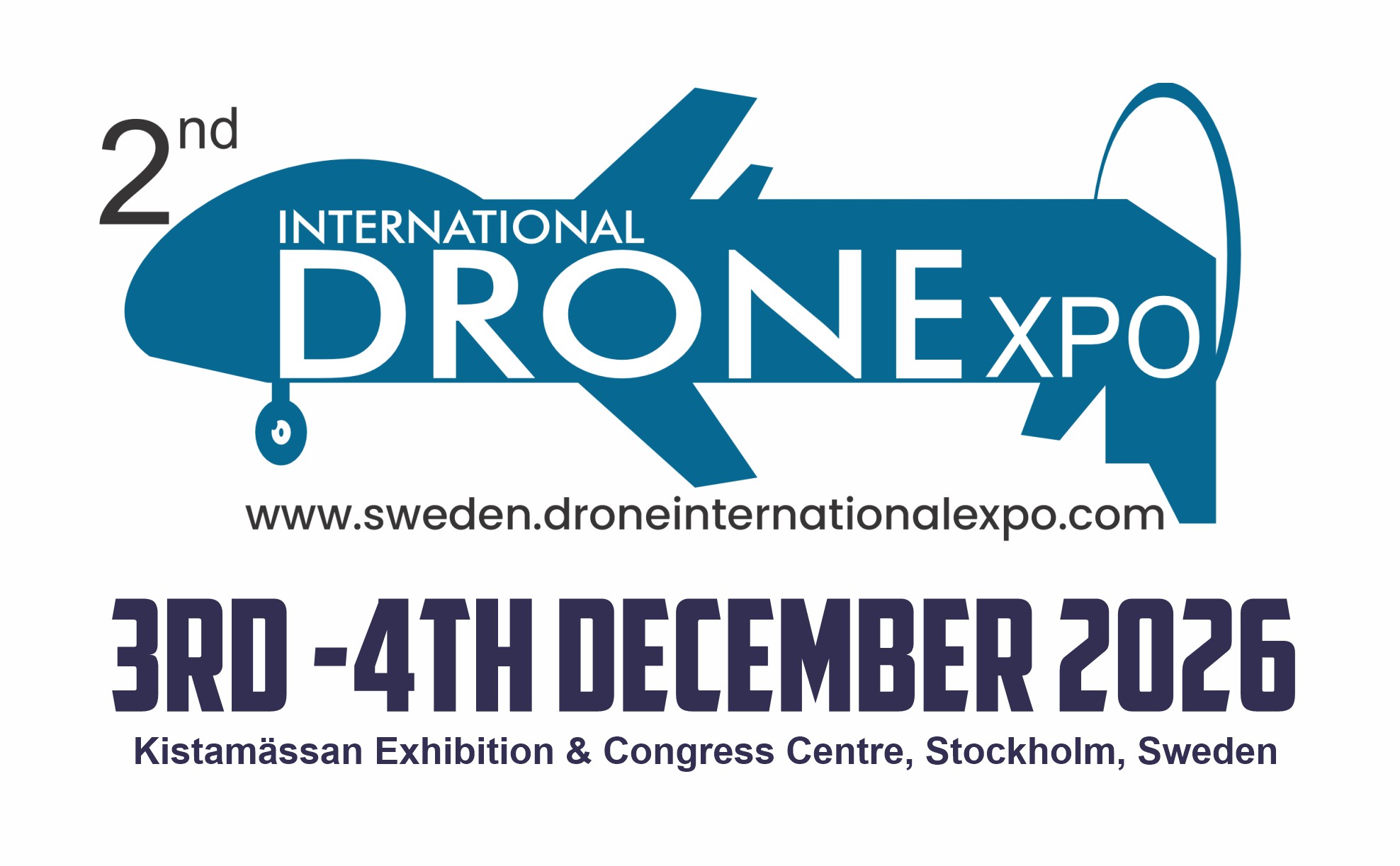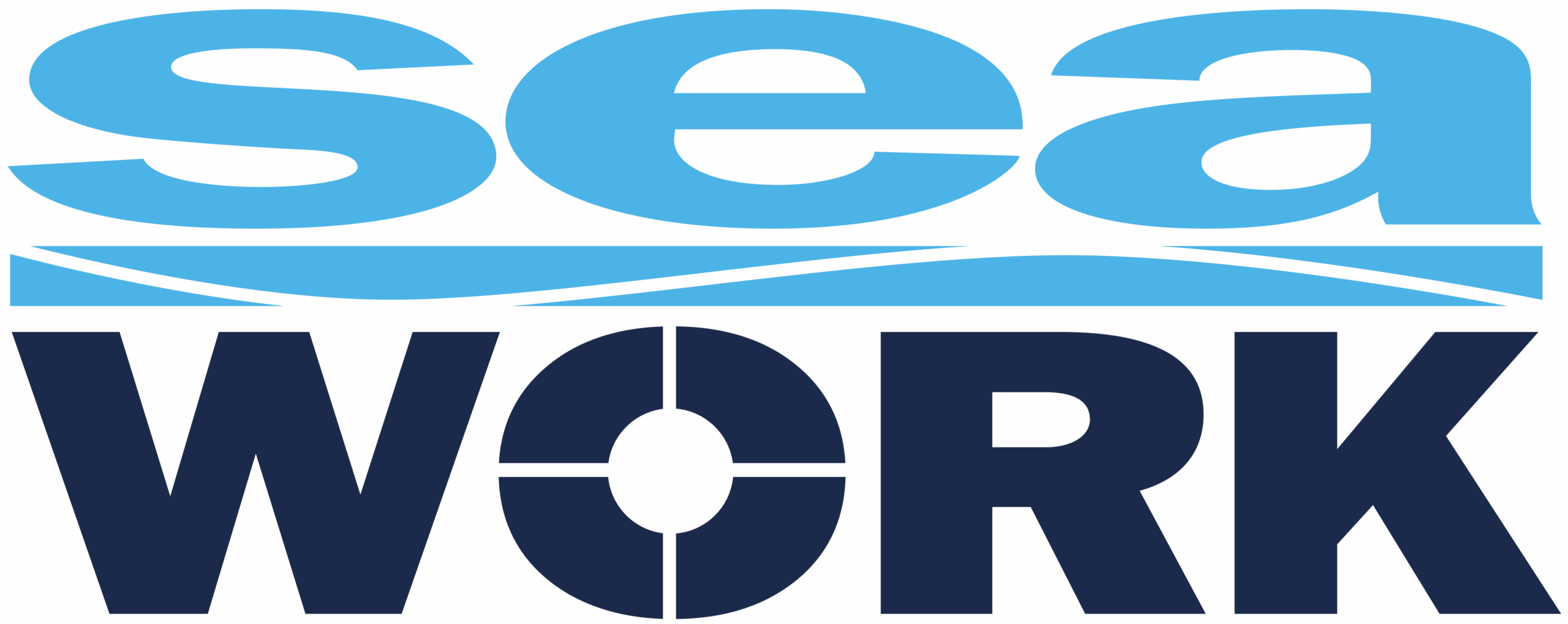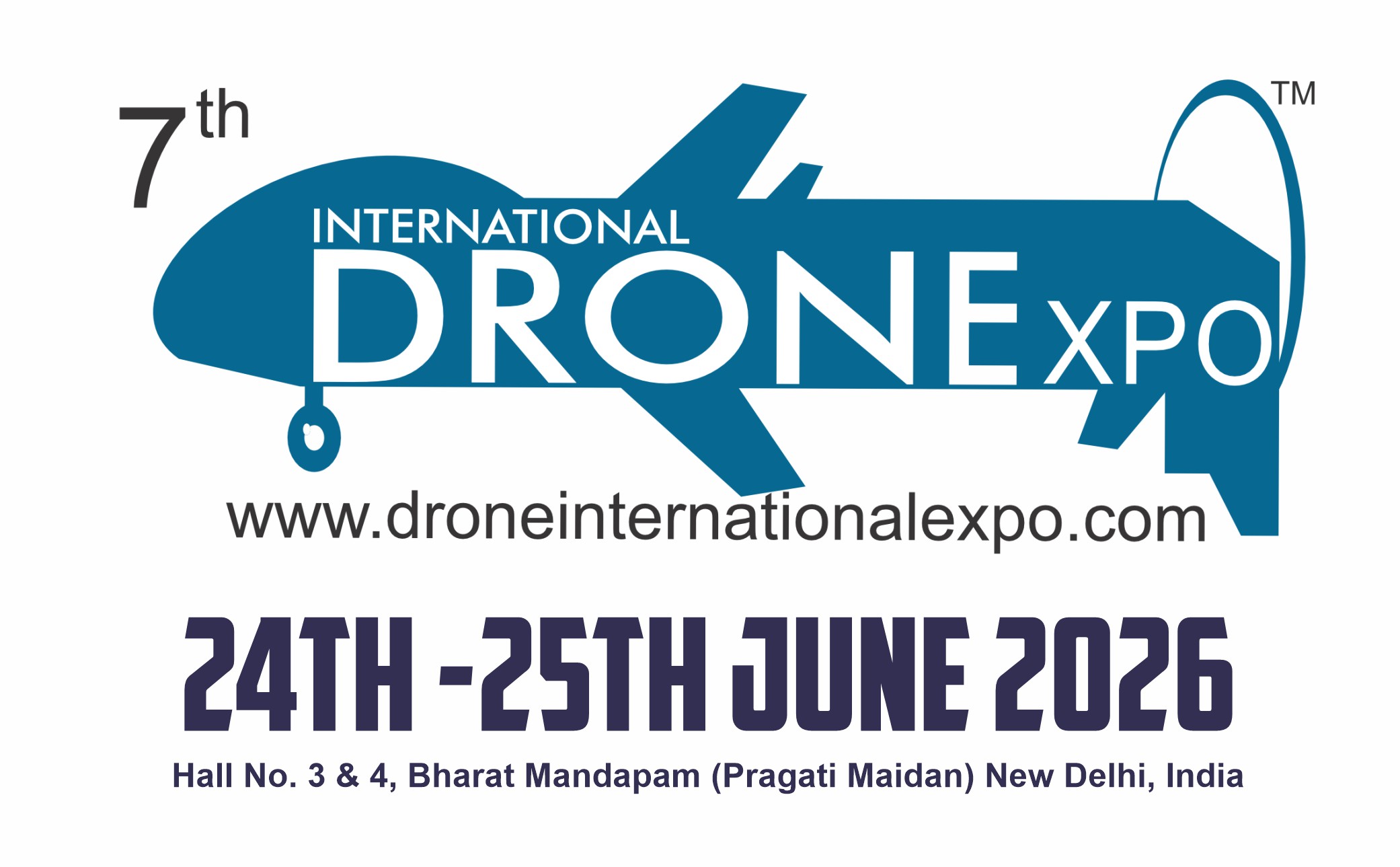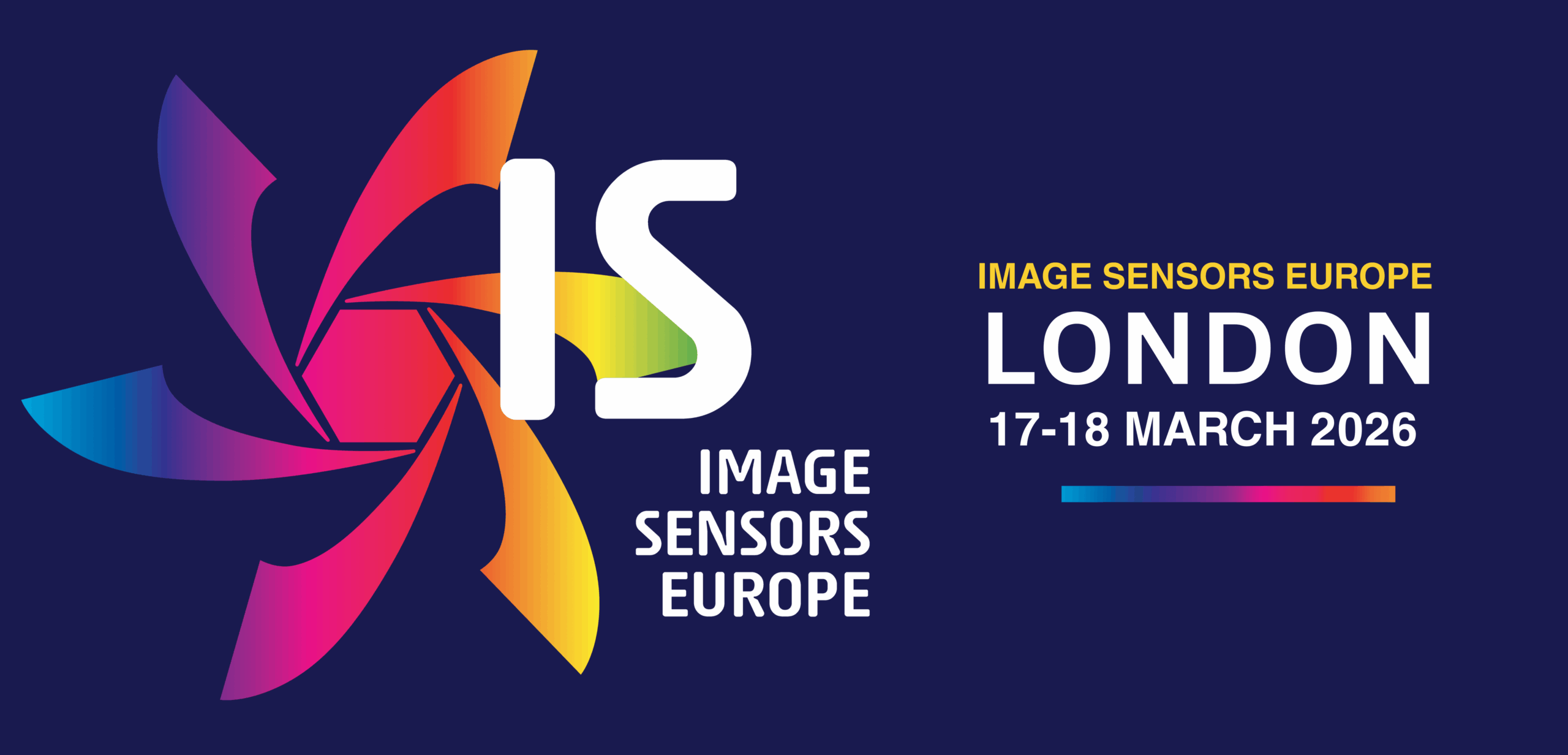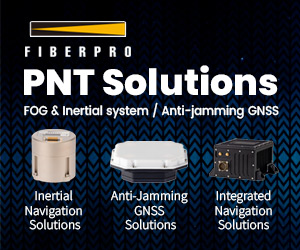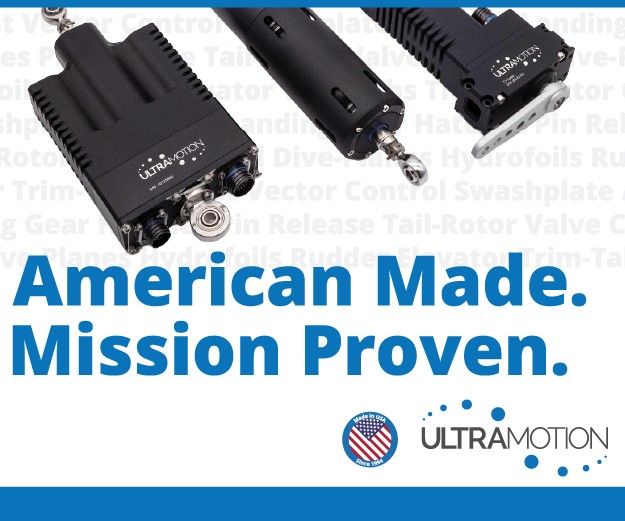2025 Paris Air Show & IDS Denmark

(courtesy of SIAE)
Lattés and Lego
Rory Jackson reports on his findings deep in the aisles of tech expos from Western to Northern Europe
From late spring through early autumn each year, the world is rife with trade shows and new tech reveals.
Europe especially has become a hotbed for uncrewed innovations over the past few years. This may not come as a surprise, given the continent’s particular ramp-ups across defence capabilities in the face of mounting conflict at its borders, and greater pushes for technological capabilities and industrial capacities to support the growing ambitions of its military industries.
As a result, a rising number of exhibitions dedicated to uncrewed systems are taking centre stage, and shows historically dominated by crewed aircraft are now sharing space with their autonomous cousins.
With so much to see, and so much being unveiled for operators and manufacturers of uncrewed vehicles, we dropped in to Paris and Odense this June, to scour the Paris Air Show and the International Drone Show (IDS) Denmark, respectively, for interesting new aircraft and technologies – a selection of which we report on here.
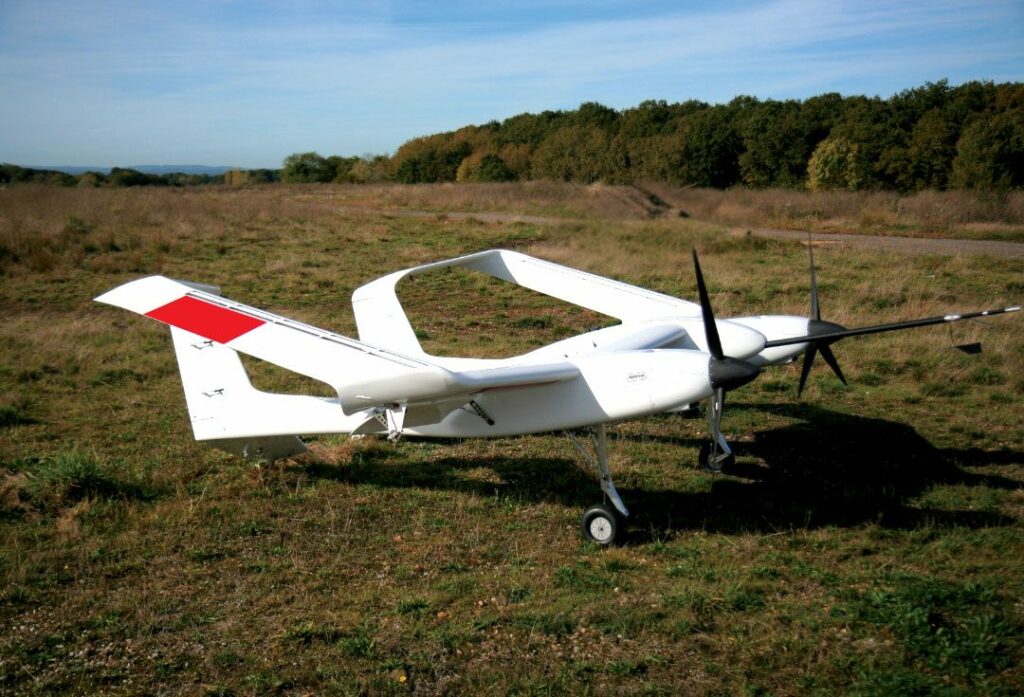
Danielson Aircraft Systems exhibited not only its Trident series of diesel engines (including the 100TD2, as featured in detail in Issue 62), but also a 40% scaled version of its ExSTOL UAV platform, an aircraft with a distinctive pair of annular box wings, each of which sweeps back and joins with its own nacelle-mounted outboard tail fin.
“We designed this UAV configuration to achieve very, very short take-offs and landings, as well as long flight endurances, and 400 kg of combined fuel and payload carrying,” explained Benoit Delaporte of Danielson.
That allows flight performances of 52 hour endurance with 350 kg of fuel and 50 kg of payload systems, or alternatively 20 hours of flight when equipped with 150 kg of fuel and 250 kg of payload.
“There are four core engineering principles we focused on to achieve both of these,” Delaporte continued.
The first is the aforementioned and unusual wing and tail configuration, utilising the concept of a ‘Prandtl box wing’. By sweeping and looping each wing to join with its tail, winglet drag is eliminated, and lift-generating surface area is maximised with respect to the total wingspan length extending out from the fuselage.
Second, the craft’s two nacelles each house an engine – each a triple-inline, 100 hp, Trident 100TD2 – to ensure sufficient power delivery and runtime per flight.
Third, each mounts a tractor propeller with a blade diameter close in size to the wingspan. Hence, when the engines run at take-off power, as well as the props pulling the aircraft forward, they blow air about the wings, creating a large pressure differential around them and thus forcibly generating very high wingborne lift. This enables the UAV to achieve take-off without needing the ground speeds typical of CTOL aircraft.
“Lastly, we are completing a specially researched and designed variable-pitch propeller, which will be highly optimised for maximising torque and power efficiency for this aircraft, particularly at low velocities,” Delaporte noted.
As a result of these and other engineering focuses since ExSTOL’s inception in 2015, the 1050 kg MTOW, 8 m wingspan craft is anticipated to need just 98 m D15 for take-off and 90 m D15 for landing – the ‘D15’ indicating that an obstacle of 15 m height can be overpassed after 98 m for take-off and within 90 m for landing. In essence, the air vehicle’s wheels will leave the ground after 45 m of take-off distance and, similarly, a full landing will be completed 45 m after the wheels touch down.
That makes it compatible with a range of helicopter carriers and similar light carrier vessels, rather than depending on full-scale aircraft carriers or airfields, as the company notes.
“Extensive CFD work and wind tunnel work were key to generating and optimising this design, especially thanks to the support of our neighbour and partner at Magny-Cours, Aero Concept Engineering,” Delaporte added.
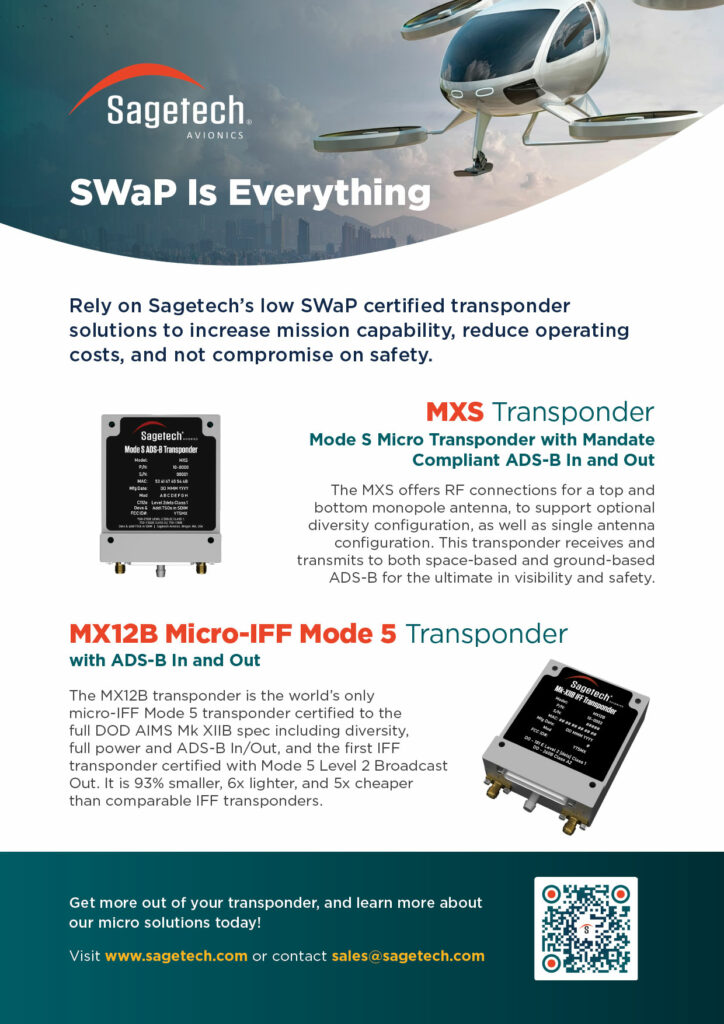
“Aero Concept Engineering owns and operates a wind tunnel facility highly proven in motorsport and now aerospace, and it has developed its own unique and very realistic CFD simulation software – ACE of Aircraft – specifically to simulate and improve the aerodynamic efficiency of low-speed UAVs [those travelling at less than Mach 0.35] for manufacturers that cannot yet afford extensive wind tunnel time.”
RIEGL showcased two of their latest VUX-series Lidar sensors: the RIEGL VUX-100 and the RIEGL VUX-120.
“The RIEGL VUX-100-25 provides an extra-large field of view of 160° and a very high pulse repetition rate of up to 1.5 MHz, enabling high productivity for surveying large, even complex areas,” said Michael Mayer, managing director of RiCOPTER UAV GmbH, a RIEGL company.
“Typical applications include power line, railway track and pipeline inspection, assessing topography in open-cast mining, surveying of urban environments, archaeological and cultural heritage documentation and forestry.”
The RIEGL VUX-120-23 meanwhile performs with a 2.4 MHz pulse repetition rate, and is designed to provide very dense results from higher-than-conventional 720 m flight altitudes. The system’s NFB-scanning capability – the consecutive nadir-forward-backward scan direction – is noted by the company as an advantage in such applications as narrow, canyoning situations, allowing data capture on vertically oriented structures (such as buildings in urban canyons or mountainsides).
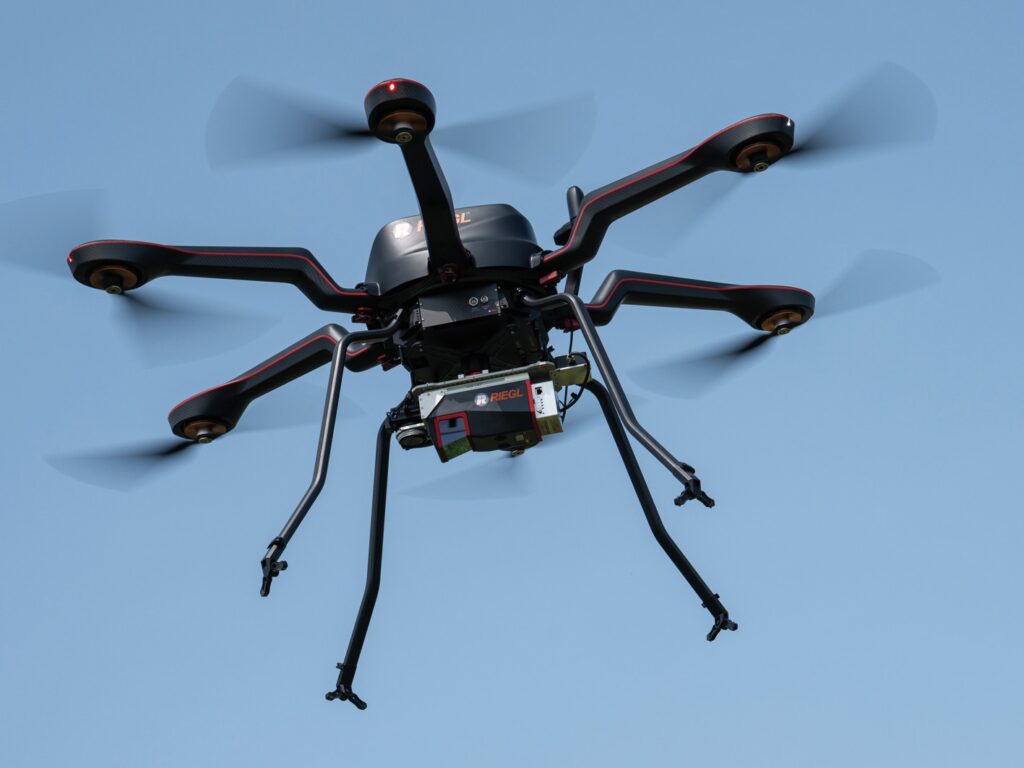
Both sensors can be equipped with RiLOC, RIEGL’s GNSS-IMU solution (specifically, either RILOC-E-25 or RiLOC-F) for simplified provision of a fully integrated and calibrated system from a single supplier, without needing third-party software, maintenance or support. The combination of the scanner and RiLOC offers survey-grade performance in the smallest possible form factor and weight.
Additionally, both systems may be installed on a wide array of aircraft, including small multi-rotors, and integrate sufficient computing power to process all trajectory and scan data onboard in RIEGL’s RiPROCESS software, and also to check survey completeness and perform other initial analyses in the field.
Pipistrel exhibited its Nuuva V300 cargo UAV, a striking sight as one of the largest static UAV displays at the event.
“The Nuuva V300 is a long-range, large-capacity hybrid-electric VTOL cargo drone, which has been in development for some time at Pipistrel, which is now part of Textron,” said Gabriel Massey of Pipistrel.
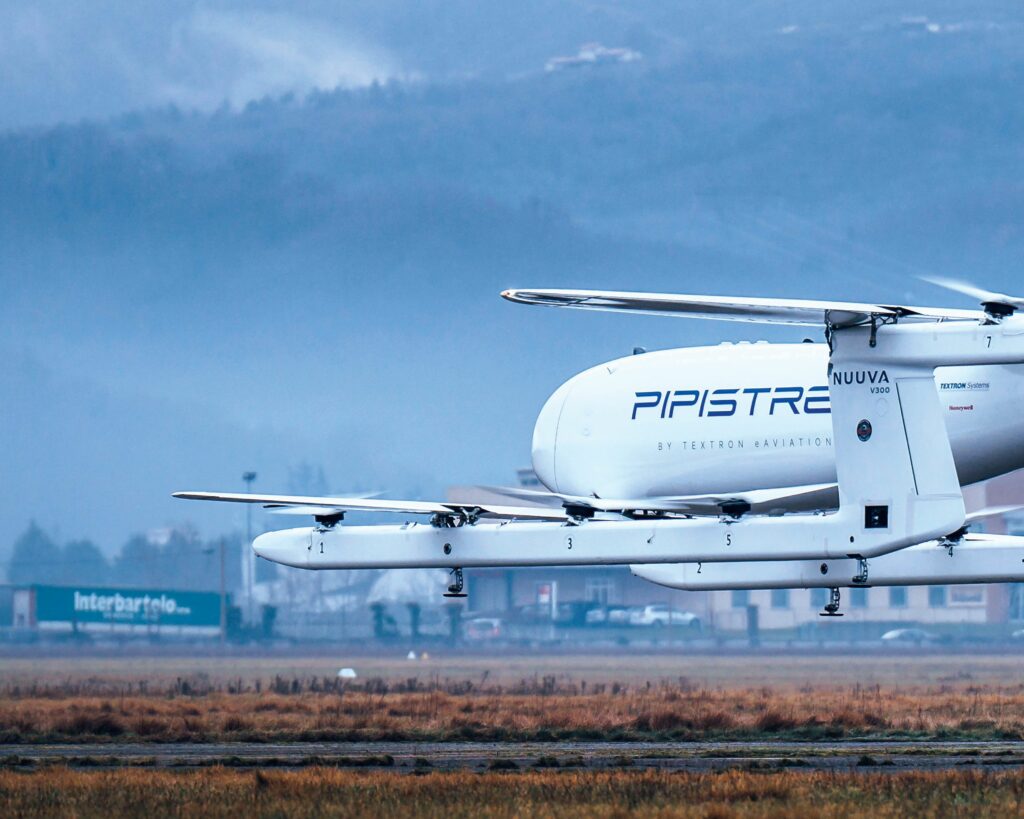
“Developing this aircraft was appealing to us in terms of the efficiency and cost-reduction opportunities that bringing both hybrid-electric power and uncrewed autonomy into logistics presented.”
The Nuuva V300 is so named as a rough match for its 272 kg ideal payload capacity, although the actual maximum cargo capacity is 408 kg, and its maximum range is estimated to exceed 600 nm (1111.2 km); in practical terms, the company anticipates the Nuuva V300 will carry 600 lb (272 kg) over 300 nm (555.6 km) as a comfortable operation.
“It features eight electric lifter motors, and the engineering of those has drawn heavily from lessons we learned making our Velis Electro – presently, the only type-certified electric aeroplane in the world. In fact, the Nuuva V300’s lifter motors are a variation of the type-certified tractor prop motor in the Velis Electro,” Massey added.
“There are eight batteries, one per motor, and those were all developed in-house and integrated with our own inverters. Meanwhile, we’ve also got a FADEC-governed reciprocating engine at the rear for horizontal thrust, which can fly on avgas or mogas – its fuel tanks sitting in the cargo hold.”
In flight, once take-off is completed, the electric rotors align their propellers with the nacelle-like landing struts and upper tail booms (six rotors mounting on the former; two on the latter) to minimise drag, and then the gasoline engine takes over.
“The body is 100% carbon composite, manufactured in Slovenia, to maximise weight efficiency and thus logistical cost-efficiency. That’s also key to maximising the lift-over-drag coefficient of each of the two wings, to really be flexible in optimising the design of the aircraft,” Massey concluded.
Elmer Aviation is a spin-out from custom OEM race engine manufacturer Elmer Racing in Finland, which is aiming to provide highly specified, bespoke reciprocating engines to UAV producers and other professional aircraft companies.
“Among the racing engines we’ve produced, our leading success has been our 4 L ‘Thor’ engine: a turbocharged, inline, four-cylinder four-stroke, and the highest power-to-weight ratio OEM circuit racing engine series ever made, recommended for 1500-2000 hp while weighing 150 kg complete, turbo included,” said Oskar Elmgren of Elmer Aviation.
“We also have a 2 L i4 – essentially a bolt-in replacement for the Mitsubishi Evo X. Our newest engine, ‘Hel’, a 5000 cc, 4000 hp, 60° V6 made for drag-and-drive events is almost ready to ship to customers; a version of that with aviation-type lifespans would likely be about 1000-1500 hp and weigh 195-200 kg. We’re working on a 120° development of it [called ‘Fenrir’] for a European supercar manufacturer, offering better rigidity, a lighter crankshaft, and minimised vibration.”
Elmer also has a ‘Kára’ design concept for a smaller turbocharged i4 drone engine for 80-150 hp output, weighing 35 kg all-up.
The company’s engines have been spark-ignited to date, but Elmer is also closely familiar with compression ignition systems. Many of its high-level racing engines were built with maximum cylinder pressures equivalent to or exceeding that of diesel engines, and its team is capable of reviewing and customising appropriately for the necessary design differences in piston crowns, combustion chambers and thermal management systems.

“The main technical advantage we have is that our billet design type is very cost-effective and quick to design,” Elmgren added. “As a core principle, we machine from billet for all our parts because that lets us use stronger aluminium alloys with very thin wall thicknesses, resulting in reduced weight and increased power and performance over cast components. It also allows very quick iterations and design changes, even during manufacturing.”
Windracers displayed its ULTRA MK2, the latest and improved version of the fixed-wing aircraft we featured in Issue 43 (April/May 2022).
“The most obvious change on the MK2 is its different engines: we’ve gone to a pair of Hirth two-stroke F23 engines, which give us a lot more power than our previous supplier,” said Stephen Krajewski.
“While we’re watching developments with electric and hydrogen, we continued with combustion engines because they’re the practical choice for middle-mile air cargo based on cost and performance but also on carbon impact.
“Windracers ULTRA is designed to work in remote locations in Africa and elsewhere where charging infrastructure is scarce, and batteries lack the energy density needed for long-range, heavy-lift flights. In these contexts, combustion offers a better balance of capability and operational sustainability – especially for humanitarian partners like Aviation Sans Frontières.”
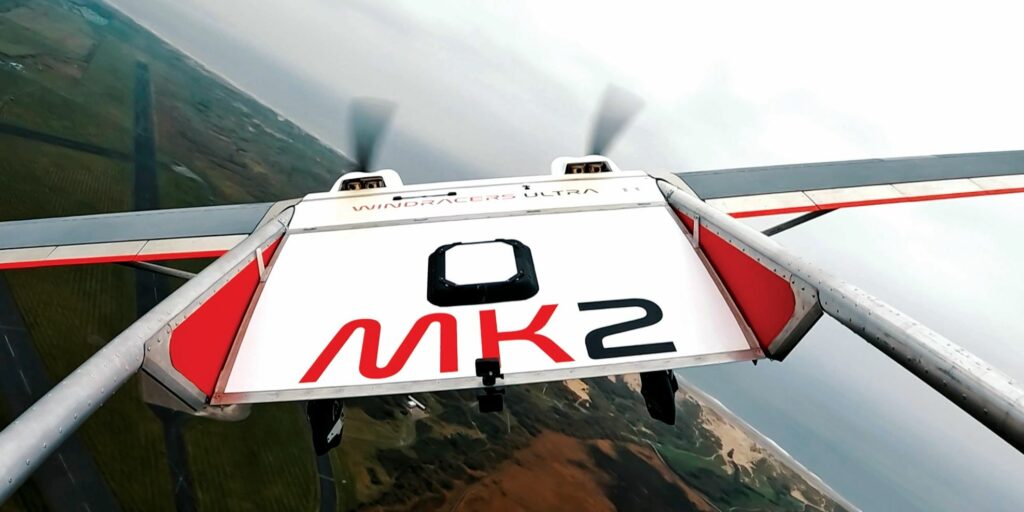
Meanwhile, the UAV’s tail boom has been redesigned as an inverted V-tail with increased outward extension, enabling more efficient weight with the same controllability (possibly more, pending further tests) as before. Its undercarriage has also been updated with larger wheels, springs and braking components for better overall robustness.
“Technicians in remote locations need to be able to maintain and repair this UAV, so we’ve continued to opt for simplicity and standard parts, keeping and improving robustness of the tricycle undercarriage, as an example,” Krajewski added.
“Overall though, these upgrades have increased the useful load capacity from 100 kg up to 150 kg, and we’ll also have some definite numbers in future as to by how much our 1000 km range has increased.
“Carrying more means the UAV supports more use-cases, including using the drop doors to deliver freight by parachute, and we can integrate more sensing equipment onboard. The NORCE [Norwegian Arctic Survey] bought two Windracers ULTRA MK2s and are integrating an ice penetrating radar and antennas onboard both of them. We’re also working on permissions for a flight from the UK to Norway; that’ll be possibly the longest cross-border commercial UAV flight ever.”
Topotek, a Beijing-based Chinese gimbal manufacturer, showcased an extensive portion of its portfolio of weight-optimised, multi-sensor gimbals in varying configurations at the air show. The company specialises in advanced stabilisation solutions tailored for aerial and defence applications, and aimed to highlight its works in advanced gimbal technologies.
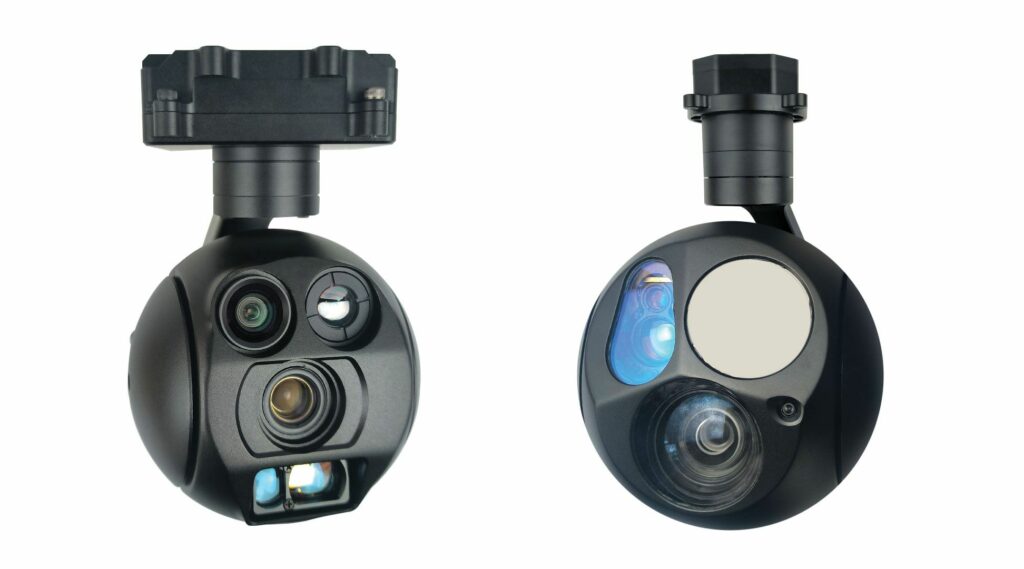
“The E40S48G12L30 is one of our largest gimbals – a high-performance quad-light pod equipped with 40x lossless zoom, a 48 MP fixed-focus camera, a 1280×1024 thermal imager with a 25 mm lens and a 3000 m laser rangefinder,” said Dr Junaid Haider of Topotek.
“With so many uses across industries, this versatile system excels in search and rescue, precision farming, industrial inspections, border security and wildlife monitoring. Whether tracking endangered species, scanning crop health or inspecting remote infrastructure, its combination of long-range zoom, thermal vision and laser measurement capabilities deliver extensive and detailed visibility where ordinary methods fail.”
The company’s gimbals are fully compatible with Pixhawk, QGroundControl (QGC) and ArduPilot, supporting MAVLink, Datalink, UDP and TCP/IP protocols, together with SBUS, PWM and UART control interfaces.
“At 360 g, the EHP03G6S86D15 is highly suited to drone and eVTOL payload applications: a quad-sensor gimbal with 48 MP fixed-focus, 3x optical zoom, 640×512 thermal imaging, and a 1.5 km laser rangefinder – plus HDMI/network outputs for real-time streaming – all in a SWaP-optimised package.”
Additionally, the company’s gimbal cameras are AI-powered to feature detailed tracking and monitoring capabilities. Those include supporting target recognition for people and cars (so long as they cover at minimum 32×32 pixels in any given image), as well as tracking objects from 16×16 to 256×256 pixels, handling occlusions of up to 2 s, tracking speeds up to 50 pixels/frame and recognising up to 100 targets simultaneously.
Parrot Group unveiled its CHUCK 3.0, a turnkey autonomy module for turning theoretically any aircraft platform into a functioning UAV. The system, built around an autopilot, includes flight sensors, comms and a multi-sensor gimbal.
“We’ve developed micro-UAVs for the past 15 years, and wanted to condense all of our knowledge in AI, radio, optics and other disciplines into a single, plug-and-play module,” explained Chris Roberts of Parrot.
Using CHUCK, as a modular and scalable solution, means an integration path of four months for most UAV suppliers. Roberts pointed toward countries such as Ukraine, which have hundreds of drone makers in need of highly capable autonomy solutions deliverable in scale and with short lead times, as potentially ideal customers for CHUCK.
To that end, it integrates military-type radios and anti-jamming and -spoofing capabilities for long-range stealth operations, as well as the aforementioned gimbal and sensors for optical navigation.
“For comms, CHUCK has a frequency-hopping military grade radio called MARS, together with 5G and our LoRa radios,” Roberts added.
“And for European sovereignty, there’re no components from China, and you don’t have to be connected to the cloud to use it. All processing is done onboard and in real-time thanks to a Qualcomm chipset.”
Parrot also unveiled the ANAFI UKR drone range, which is a family of compact ISR UAVs aimed at defence, law enforcement and public safety applications, engineered for tight cybersecurity, resilient comms and navigation, and compliant with NDAA, Blue UAS and GDPR standards.
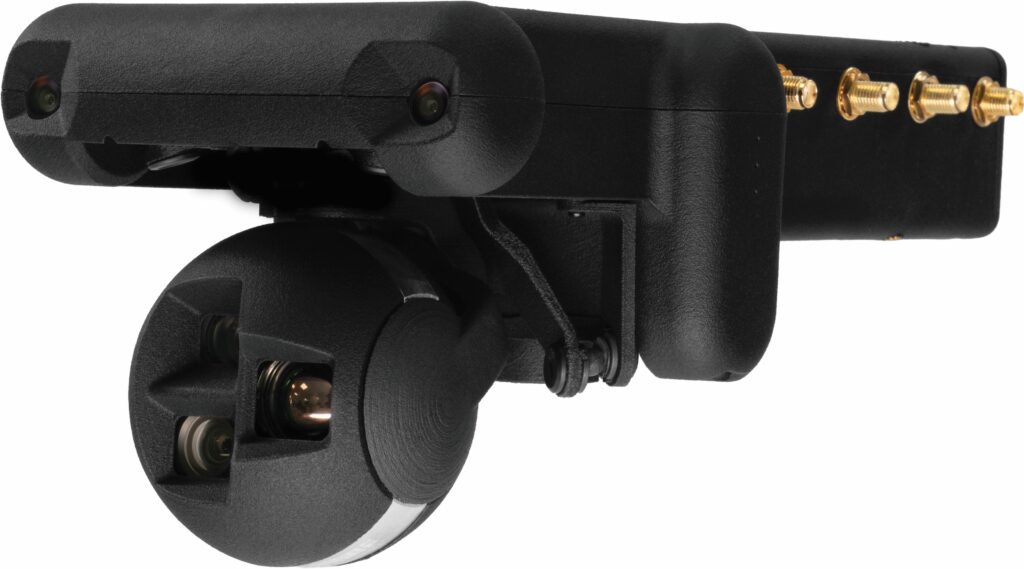
The UAVs’ onboard software includes optical navigation via visual-inertial odometry and intelligent positioning via image matching, as well as real-time classification and tracking of various targets.
We first (indirectly) featured Norway-based STABLE and its gyro-stabilised platforms in Issue 45 (Aug/Sept 2022) for their use by Brazilian USV manufacturer and operator TideWise on the 1400 kg USV Tupan.
At the International Drone Show Denmark in Odense, STABLE exhibited a working and powered demo of its scalable stabilised platform, and STABLE’s Rune M. Eriksen was on-hand to explain how its engineering has been optimised for various applications, including the safe landing and take-off of drones from moving vehicles.
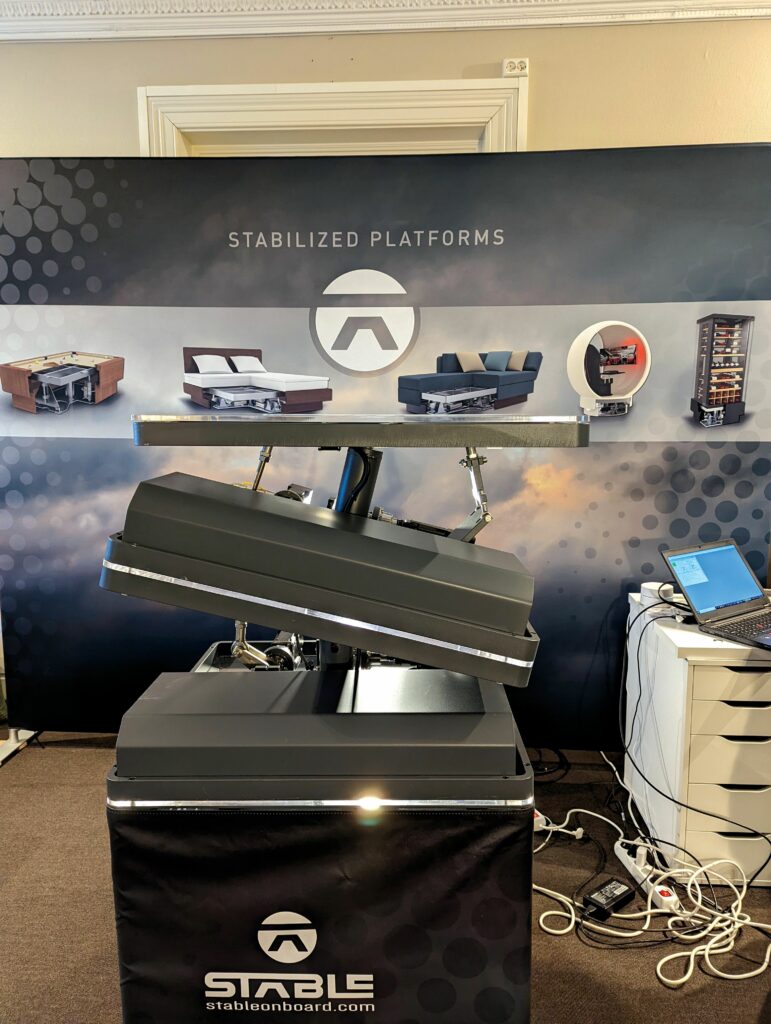
“It’s a fully electric system, all powered and driven by electric servo motors; it nominally runs on 230 V AC, but may be fed from 12-24 V DC inputs, and all control electronics and inertial sensors are integrated inside the system so that the end-integrator needs only to provide power,” Eriksen said.
“By using electric systems rather than hydraulics to stabilise the platform against pitching and rolling, energy efficiency is greatly improved and mechanical complexity is reduced.”
As standard, the platform architecture runs on just two servo motors: one for pitch and one for roll. The structure routes most loads to a central pedestal, such that the motors only provide balancing, rather than needing to be large or powerful enough to withstand or route forces.
“We also integrate efficient planetary gears to translate high-force and -torque motion into the speeds of the motors; theoretically, we could achieve the same effect with linear actuators but we’ve had consistent and good results with this configuration,” Eriksen noted.
“And our platforms can be custom-scaled to accommodate objects of theoretically any size and weight; to give you an idea of how literal that is, a partner asked us for a 20 m by 10 m stabilised paddleball court on a ship: ‘Why not?’ was our answer!”
Elsewhere at the IDS Denmark, Frost Unmanned showed us its Tracer 160 UAV, which is designed as a low-profile, high-speed aircraft for applications such as tactical attack and interception missions, as well as reconnaissance and testing of targeting systems.
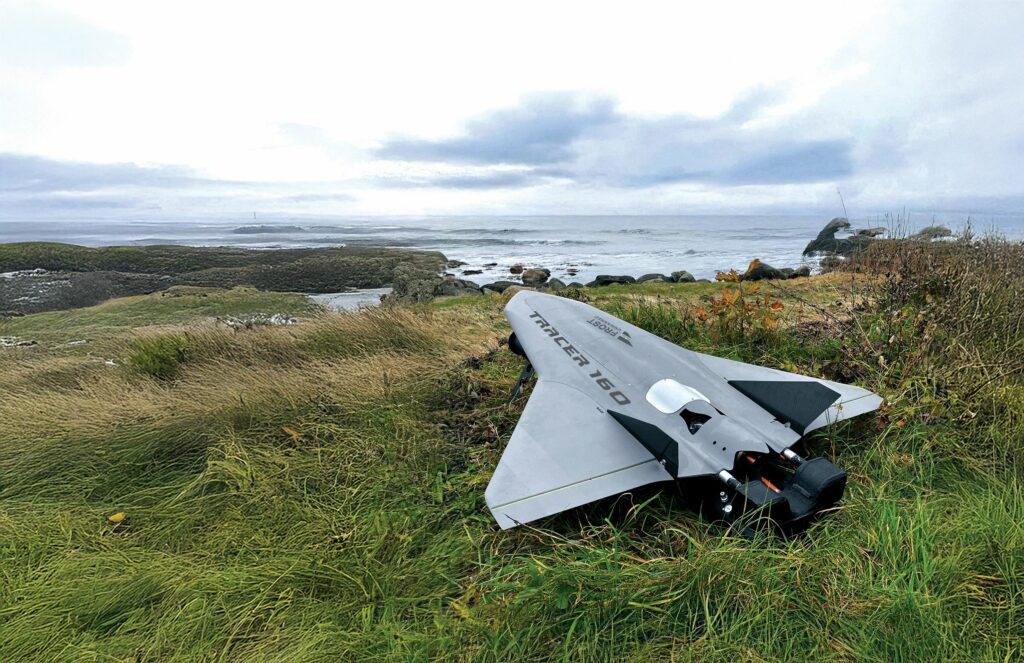
“It has a flight endurance of 60 minutes, and a flight range of up to 200 km, with LOS comms providing connectivity up to 40 km,” said Kamil Poniatowski from Frost Unmanned. “The system flies using an AI-based flight controller operating our own custom software.”
The 15 kg UAV is constructed with a lifting body design, with identical wings on both its left and right sides and its aileron servos embedded in the fuselage, easing wing replacement between flights. The system is catapult-launched, the company’s catapult integrating its own battery and data link so that it can be triggered and operated remotely. A bay on the Tracer 160, forward of the engine, houses a parachute for autonomous landings.
A 100 mm diameter microturbine engine enables the UAV’s 160 knots maximum speed (110 knots cruise), with just under 14 kg of thrust produced. “It’s a good engine, running up to 230,000 rpm at full throttle, and you can fuel it with Jet A-1, or just diesel is fine if you add 5% turbine oil,” Poniatowski added.
Protech, a supplier of additive manufacturing systems in Nordic counties, attended the show to display some of the additive printers it can provide to parts manufacturers, UAV technicians and others.
“When it comes to high-end printing, Stratasys’ FDM [fused depositing modelling] printers are very reliable and able to print some of the very best materials suited to aerospace applications,” Thomas Tønnesen at Protech Denmark said.
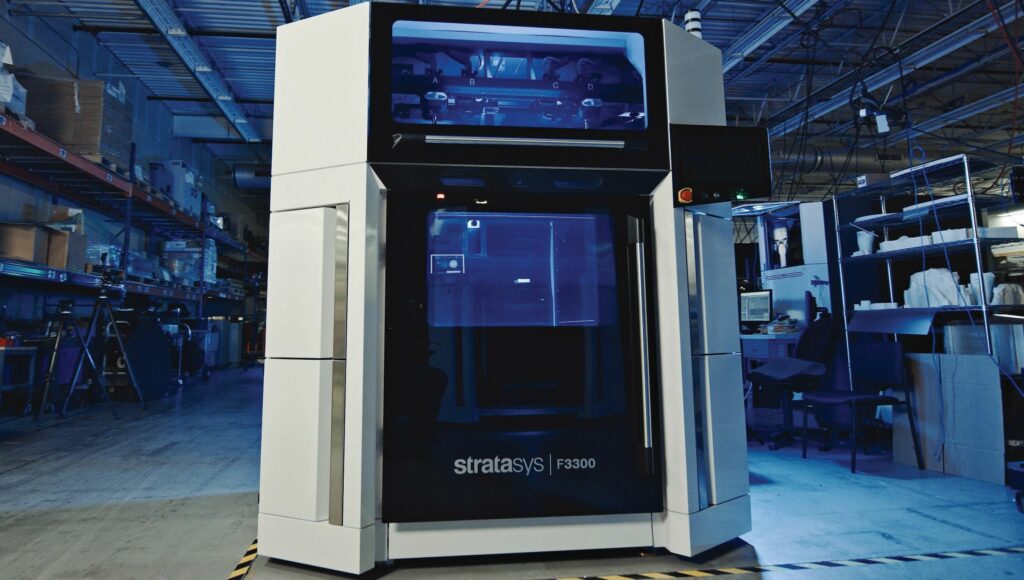
Key examples of such materials are Nylon 12CF, which combines a Nylon with 35% carbon fibre content, enabling high strength-to-weight for UAV hull parts, and some Ultem systems, a high-temperature and chemical-resistant resin approved for use in commercial aeroplanes.
“Additionally, the Stratasys SAF is a powder bed laser sintering printer, and that technology enables end-users to print in higher volumes, for instance in serial production situations. Although it prints smaller parts than the FDM technology, it does so at higher speeds,” Tønnesen added.
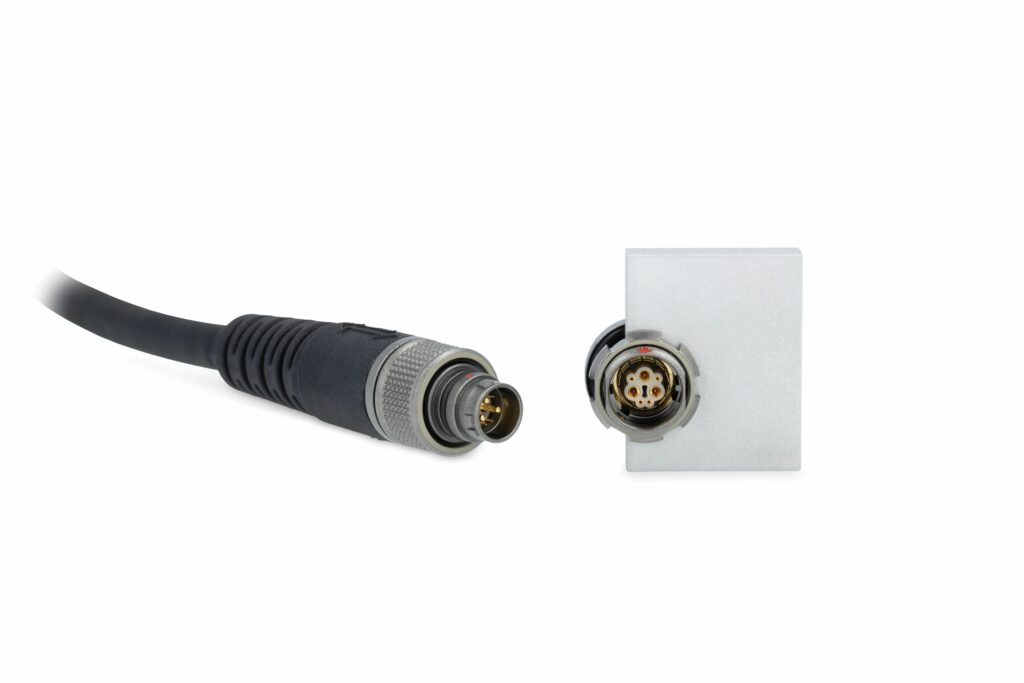
ODU showcased its AMC-HD connector series. AMC-HD stands for ‘Advanced Military Connector, High Density’, which refers to the product family’s adherence to military standards, as well as combining power and data pins within the connector housing.
“The AMC-HD hybrid connectors supply up to 10 A of current per power pin and 10.2 GB/s of data throughput per data pin – equivalent to HMDI 1.4, USB 3.2 and Ethernet 10 Gbit/s,” said Thomas Ullner at ODU Denmark.
“The housings are dustproof and waterproof according to IP6K9K, and they’re made from lightweight materials including brass with Ruthenium plating. We do the surface treatments, CNC turning, stamping of contacts and plastic moulding in-house. That means we can make customised versions in-house for customers who are seeking sufficient numbers.”
The AMC-HD connectors feature 3 to 27 contacts when configured for break-away locking. The connectors are also available with a screw-lock function. ODU offers three standard sizes of AMC-HD connectors, with diameters from 7 to 15 mm, and the expected lifespan of the connectors is a minimum of 5000 mating/unmating cycles.
R2 Wireless exhibited an eponymously named, passive RF sensing platform for remotely detecting UAVs, GCSs and other wireless devices – such as mobile phones and tactical radios – that could potentially jeopardise uncrewed operations, critical infrastructure and sensitive sites.
“It detects all incoming RF signals, classifies them, geolocates them with high precision and tracks them in real time using proprietary signal processing and edge AI algorithms,” Daniel Shizaf of R2 Wireless told us.
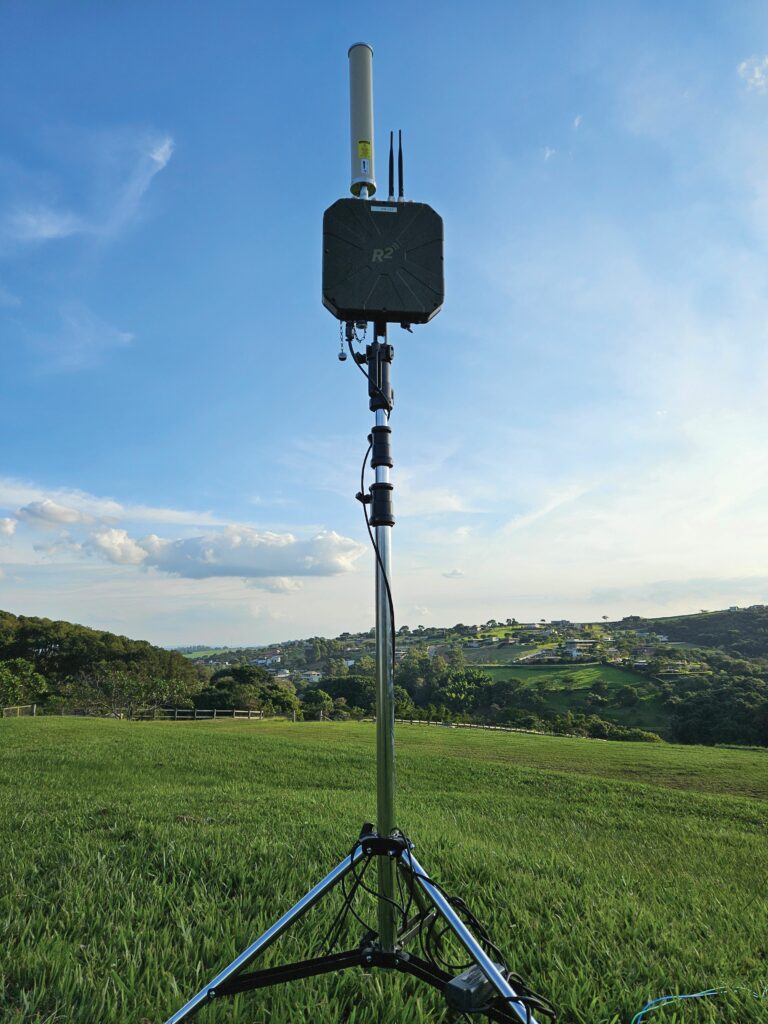
“The platform detects any type of RF device, irrespective of communication protocol, frequency or modulation, encrypted or non-encrypted signals. The sensors we’ve demonstrated here in Odense can detect and find the location of wireless signals from 8 km away.”
Each unit of the R2 Wireless detection solution consumes less than 10 W in normal operations, typically running on a small 12 V battery, and is IP67-rated for safe operations in outdoor environments and various weather conditions. Setting up the system takes around five minutes per unit and the system is ideal for remote sites, fully off grid, given that its battery enables it to work as an energy-independent unit.
Stork Drives is a Nordic supplier of electric propulsion, actuation and sensing products, which attended the show to exhibit some of the newer solutions from the Swiss-headquartered maxon motor company suitable for use in UAVs.
“One of the newest drone drive motors from maxon is a 32 mm electric motor, which can produce 1 kg of thrust when equipped with a propeller, while another new and larger one, measuring at 87 mm, produces 9 kg of thrust with the appropriate propeller mounted,” said Thomas Radtleff from Stork Drives.
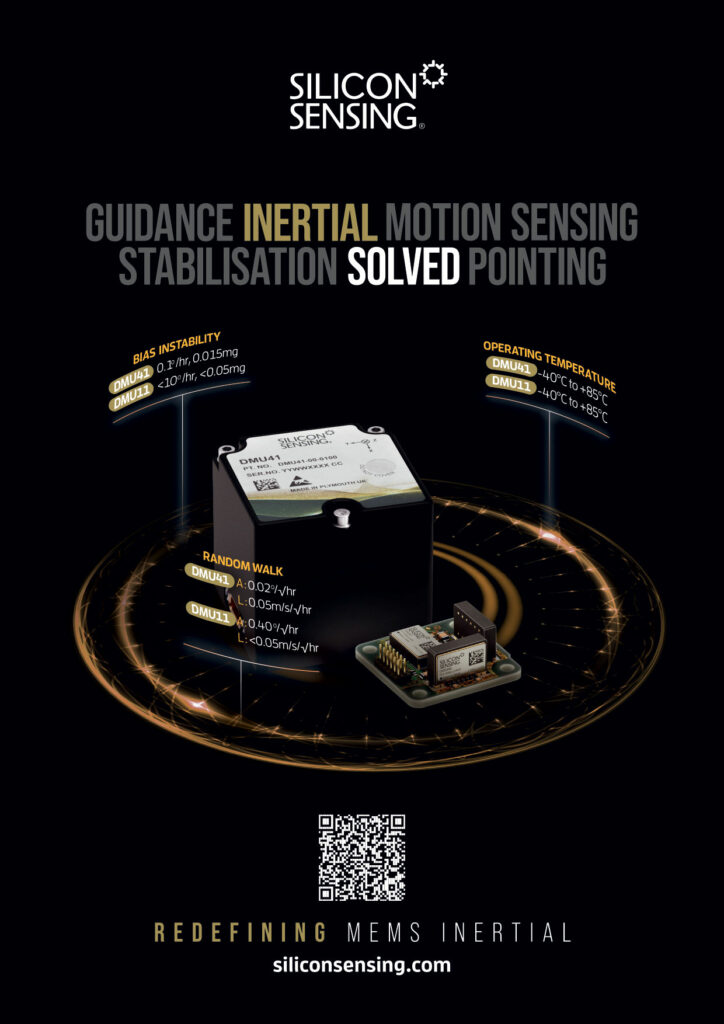
“Both are brushless DC motors, and both are constructed using a proprietary technique for the motor windings that enables them to consume very low current, which is key for helping UAV operators’ batteries last longer.
“For the motors we supply, we can equip them with propellers we receive from a business partner, and we work with customers to specify propeller designs that work with each motor to produce the amount of thrust at speed or hover that each customer needs,” Radtleff added.
Stork Drives additionally provides electric motors from maxon subsidiary Parvalux, and from Dunkermotoren in Germany.
As well as electric motors, the Nordic company provides a range of different gearboxes from these suppliers, including systems with planetary, right-angle, spur and spindle gears, on top of supplying ESCs, linear actuators, encoders, resolvers and brakes.
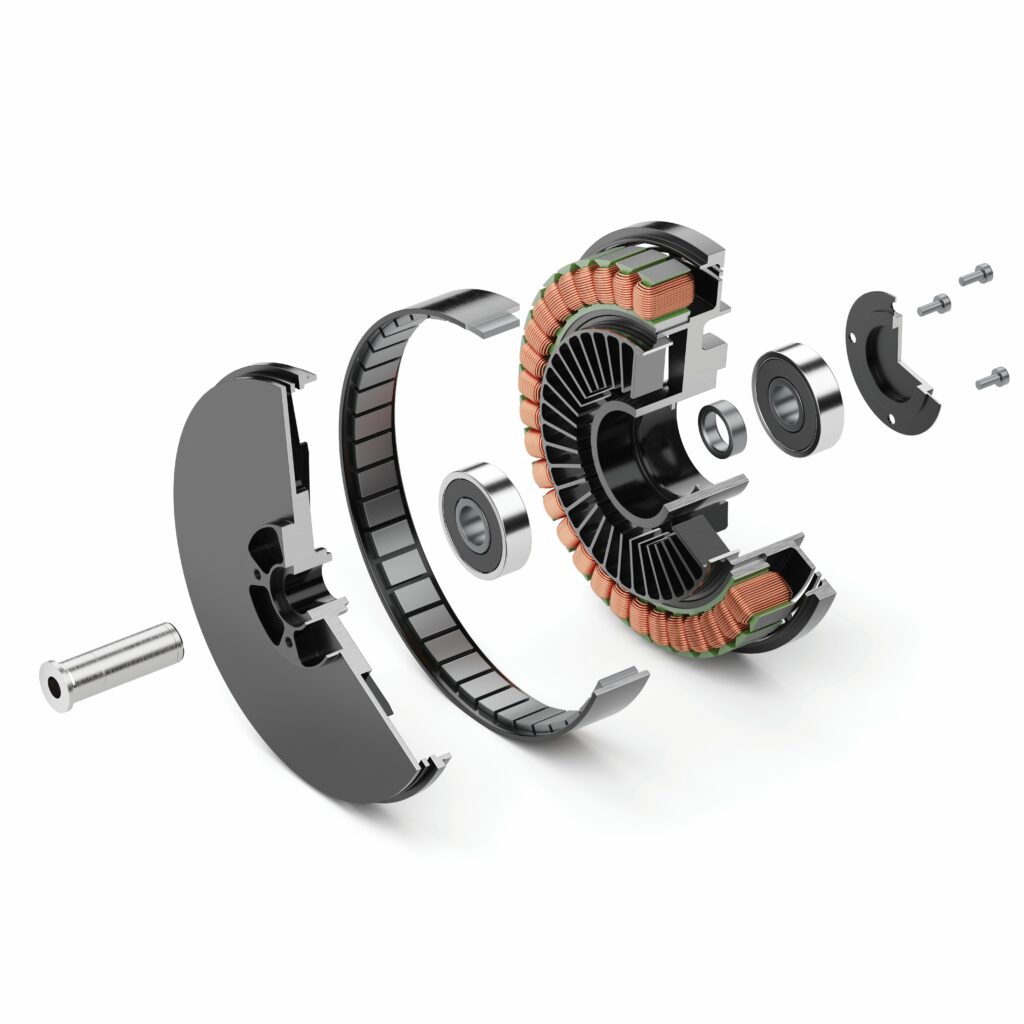
PEGASUS R&D GmbH exhibited its Drone Ice Protection System (D-IPS), developed to protect UAV rotor and propeller systems owing to their vulnerability to icing during flights in weather with cold temperatures and high humidity (including through fog or clouds).
“The system works by first detecting the presence of ice, which can be inferred by changes in the drone’s performance, such as the current draw and thus the torque of individual motors,” said David Kozomara of PEGASUS R&D. “Naturally, we can also measure local temperatures and humidity to first flag whether icing conditions are present around the UAV, and perform statistical analyses of a given UAV’s performance to prevent false positives.”
The company also has a novel Drone Ice Detection Sensor (D-IDS), being co-developed with other companies, which functions capacitively and can integrate into the structures of the propellers themselves, communicating wirelessly to a receiver module on the UAV.
Once detected, the de-icing system can be triggered. This uses a biodegradable de-icing fluid, running in lines from a central tank and pump module to small sprayers on the drone arms, which dispense droplets of the fluid onto the rotor and propeller blades at a rate of a few seconds per minute.
“Those impinge on the propeller surfaces, creating a thin film solution of the fluid and the melted ice, typically removing the ice within a matter of seconds,” Kozomara added.
“However, given that in-flight icing conditions don’t just appear and disappear, ice can reappear not long after it and the de-icing fluid have been shaken off the blades. So, the system is designed to keep monitoring for hampered rotor performance, and then keep spraying every minute for a few seconds, continually removing ice until the mission ends or fluid runs out.”
UPCOMING EVENTS


